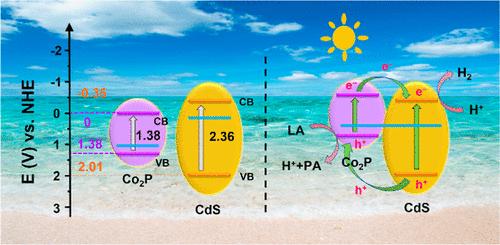过渡金属磷化物(Fe2P、Co2P 和 Ni2P)修饰的 CdS 纳米棒用于高效光催化 H2 蒸发
IF 5.3
2区 材料科学
Q2 MATERIALS SCIENCE, MULTIDISCIPLINARY
引用次数: 0
摘要
由于茧催化剂在提高催化性能方面发挥着重要作用,因此设计和制造高活性茧催化剂是提高光催化产生 H2 的有效方法。本研究采用溶热法合成了具有纳米级结构的过渡金属磷化物(包括 Fe2P、Co2P 和 Ni2P),这在很大程度上提高了 CdS 纳米棒作为协同催化剂的光催化活性和稳定性。通过优化合成和反应条件,10% Co2P/CdS 在乳酸溶液中获得了最高的 H2 产率,约为 29.24 mmol-g-1-h-1,分别是 CdS(1.36 mmol-g-1-h-1)和 1% Pt/CdS (9.63 mmol-g-1-h-1)的 21.5 倍和 3.0 倍。通过多种表征测试,不仅探究了 TMPs/CdS 活性不同的原因,还探究了 Co2P/CdS 活性增强的原因。结果表明,非贵金属 Co2P 助催化剂不仅增强了 CdS 对可见光的吸收,还促进了光生电荷载流子的有效分离。这项工作有助于进一步开发 TMPs 作为 CdS 基光催化剂的低成本、高活性助催化剂。本文章由计算机程序翻译,如有差异,请以英文原文为准。

Transition Metal Phosphides (Fe2P, Co2P, and Ni2P) Modified CdS Nanorods for Efficient Photocatalytic H2 Evolution
As cocatalysts play important roles in enhancing the catalytic performance, designing and fabricating highly active cocatalysts is an effective approach to improving photocatalytic H2 production. In this work, transition metal phosphides (including Fe2P, Co2P, and Ni2P) with nanoscale structures are synthesized by the solvothermal method, which can largely enhance the photocatalytic activity and stability of CdS nanorods as cocatalysts. By optimizing the synthesis and reaction conditions, 10% Co2P/CdS achieved the highest H2 production, about 29.24 mmol·g–1·h–1 in the lactic acid solution, which was 21.5 and 3.0 times higher than that of CdS (1.36 mmol·g–1·h–1) and 1% Pt/CdS (9.63 mmol·g–1·h–1), respectively. Testing by many characterizations, not only the reasons for different activities for TMPs/CdS but also the enhanced reasons of Co2P/CdS are explored. The results indicated that the non-noble metal Co2P cocatalyst not only enhanced the visible light absorption of CdS but also promoted the effective separation of photogenerated charge carriers. This work contributes to the further development of TMPs as low-cost and highly active cocatalysts for CdS-based photocatalysts.
求助全文
通过发布文献求助,成功后即可免费获取论文全文。
去求助
来源期刊

ACS Applied Nano Materials
Multiple-
CiteScore
8.30
自引率
3.40%
发文量
1601
期刊介绍:
ACS Applied Nano Materials is an interdisciplinary journal publishing original research covering all aspects of engineering, chemistry, physics and biology relevant to applications of nanomaterials. The journal is devoted to reports of new and original experimental and theoretical research of an applied nature that integrate knowledge in the areas of materials, engineering, physics, bioscience, and chemistry into important applications of nanomaterials.
 求助内容:
求助内容: 应助结果提醒方式:
应助结果提醒方式:


